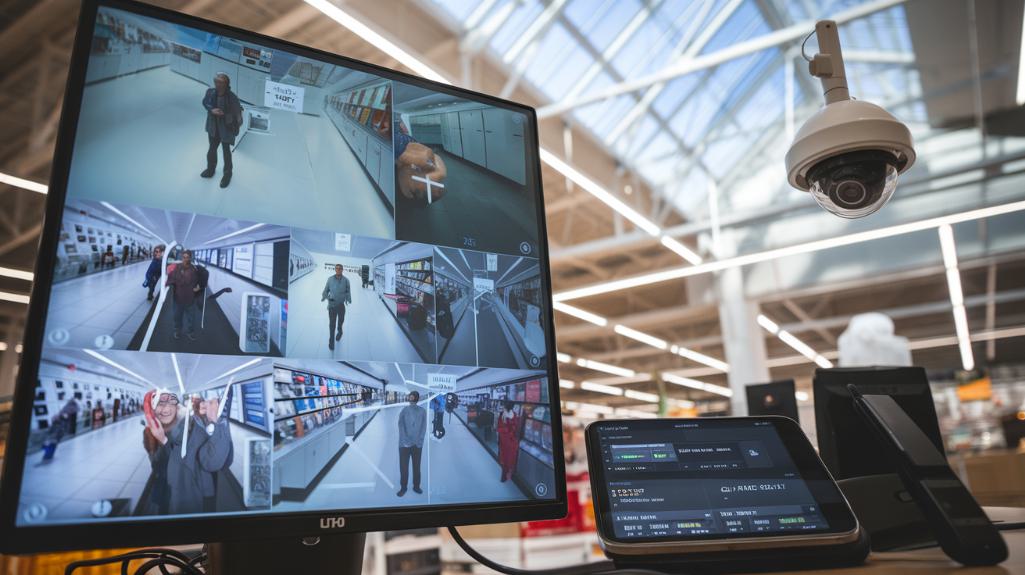Smart sensors form the technological foundation of automated theft detection by integrating advanced hardware components with intelligent monitoring systems. These sensors utilize PIR detection, machine learning algorithms, and real-time data analysis to identify potential security threats while minimizing false positives. The integration of IoT connectivity enables instant mobile alerts and automated responses through synchronized security protocols. Modern sensor systems continue evolving with AI-driven capabilities that adapt to emerging theft techniques and patterns.
Key Takeaways
- Smart sensors combine multiple detection technologies like PIR and cameras to accurately identify potential theft incidents in real-time.
- Machine learning algorithms analyze movement patterns and environmental data to distinguish between genuine threats and false alarms.
- Integrated systems immediately trigger automated responses including lockdowns, alarms, and instant mobile notifications when threats are detected.
- Advanced sensor arrays adapt their detection capabilities over time by learning new theft techniques and suspicious behavior patterns.
- Real-time data processing enables immediate verification of security breaches through synchronized monitoring of all entry points.
Core Components of Smart Sensor Security Systems

Every modern smart sensor security system relies on three fundamental components working in concert: detection hardware, communication infrastructure, and processing units.
At the core of these systems, sophisticated motion sensors like PIR detectors work alongside surveillance cameras to capture real-time data from the monitored environment. The communication infrastructure, utilizing Wi-Fi or ZigBee protocols, guarantees seamless transmission of security data to central monitoring stations.
Advanced data processing capabilities enable these smart sensors to analyze incoming information, filtering out false positives while maintaining high detection accuracy. The system's microprocessor coordinates responses between integrated security elements, including automated locks and alarm systems.
Remote access functionality allows authorized users to monitor security systems through mobile devices, receiving instant notifications of potential security breaches while maintaining constant surveillance capabilities.
Advanced Detection Methods and Technologies
Modern theft detection systems leverage sophisticated sensor arrays that combine multiple detection technologies to achieve unprecedented accuracy and reliability.
Smart sensors, particularly PIR sensors, work in conjunction with advanced detection methods to differentiate between genuine security threats and environmental disturbances.
PIR sensors and advanced detection systems work together to identify real threats while filtering out harmless environmental factors.
The integration of IoT technology with sensor technology enables extensive real-time monitoring capabilities, allowing security personnel to receive instant alerts through mobile applications.
These systems employ machine learning algorithms that continuously analyze patterns and behavioral data, leading to improved detection accuracy and reduced false alarms over time.
This intelligent approach to security represents a significant advancement in automated theft detection, offering both enhanced surveillance efficiency and cost-effective implementation compared to traditional security measures. Additionally, AI-driven learning continuously adapts detection algorithms to new theft techniques, further enhancing security effectiveness.
Real-Time Response and Alert Mechanisms
Real-time response mechanisms represent a critical component in automated theft detection systems, where smart sensors facilitate instantaneous threat identification and response protocols.
When smart sensors detect unauthorized movement or heat signatures, they immediately trigger a cascade of security measures. The system transmits instant alerts to security personnel through mobile applications while simultaneously activating integrated surveillance systems for immediate video verification.
Advanced analytics within these sensors minimize false alarms by distinguishing between human intruders and non-threatening movements.
Upon confirming a security breach, the system can automatically initiate predetermined security protocols, such as door lockdowns and alarm activation. This multi-layered approach guarantees thorough threat response while maintaining operational efficiency through automated processes, enabling security teams to respond swiftly and effectively to potential theft incidents.
Integration With Existing Security Infrastructure

Building upon established security frameworks, smart sensors offer seamless compatibility with existing surveillance infrastructure, creating a unified and robust theft prevention ecosystem. These devices integrate with CCTV systems and alarm networks while leveraging multiple communication protocols for real-time data transmission and monitoring capabilities.
Key integration benefits include:
- Enhanced access control through synchronized monitoring of entry points
- On-site data processing and analytics for rapid response
- Optimized resource allocation through precise detection mechanisms
The integration of smart sensors with existing security infrastructure enables organizations to maintain compliance while reducing operational costs.
Data Analysis and Pattern Recognition Features
Through sophisticated data analysis algorithms and pattern recognition capabilities, smart sensors excel at processing environmental inputs to detect potential theft incidents. These systems analyze movement patterns, including frequency, speed, and direction, to differentiate between normal activities and suspicious behaviors that may indicate theft attempts.
The integration of machine learning enables smart sensors to continuously enhance their theft detection accuracy by adapting to new patterns and anomalies over time. When suspicious activities exceed predetermined thresholds, the system generates actionable insights and alerts for security personnel, facilitating rapid response.
Additionally, the extensive data collection capabilities of smart sensors support the generation of detailed analytics reports on theft trends, allowing organizations to optimize their security protocols and strengthen their preventive measures against potential threats.
Frequently Asked Questions
What Is the Purpose of Smart Sensors?
Smart sensor applications enable environmental monitoring and real-time data collection, enhancing energy efficiency, safety systems, and predictive maintenance across various industries through continuous automated surveillance and immediate response capabilities.
Why Are Sensors Important in Automated Equipment?
Sensor technology enables automated monitoring through system integration, providing real-time alerts for security applications. These components are essential for theft prevention and maintaining operational integrity across automated equipment deployments.
What Are the 2 Things Smart Sensors Check For?
Smart sensors primarily monitor unauthorized movement through motion detection and environmental changes via temperature monitoring, while supporting capabilities include sound analysis, vibration sensing, light intensity measurements, and proximity alerts.
What Is the Role of Sensors in an Iot and Automation System?
Smart sensors facilitate sensor integration and data collection, performing real-time analysis of environmental monitoring parameters while enabling predictive maintenance and energy efficiency across IoT and automation system networks.
Conclusion
Smart sensor systems have proven essential in modern theft prevention through their advanced detection capabilities and seamless integration with security infrastructure. The combination of real-time monitoring, automated response protocols, and sophisticated pattern recognition algorithms enables rapid threat identification and mitigation. As sensor technology continues to evolve, these systems will further enhance automated security measures through improved data analysis and predictive capabilities.



